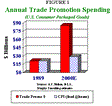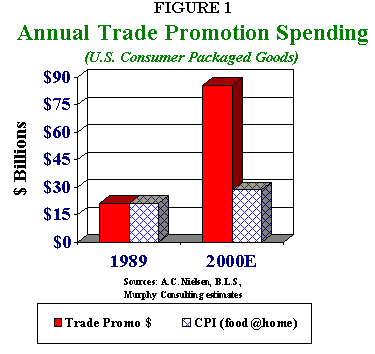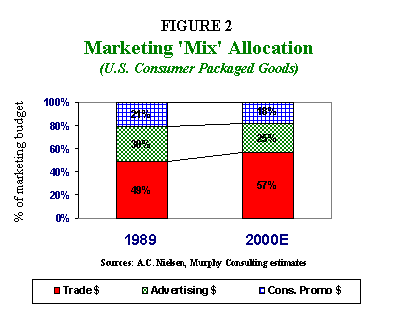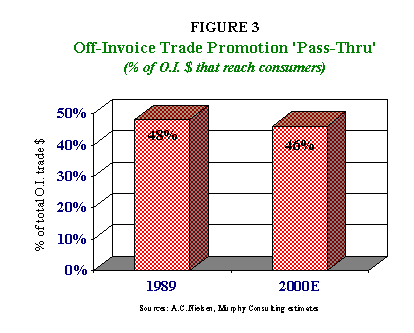The trade promotion quandary: Zero-sum or win-win?

Trade promotion spending is the second-largest P&L expense item after cost-of-goods-sold. What do you have to show for this cost of doing business? Let's take a look…
By Tim Murphy
Contents
A necessary evil?
Paradox lost
Art vs. science
Getting to ‘win-win'
The simultaneous equation
Next steps
For many consumer packaged goods marketers, trade promotion is seen as a ‘zero-sum' game in which the financial gains of one party come at the direct expense of the other. Specifically, the view is that trade promotion spending primarily benefits the retail customer, with little or no return for the supplier.
Certainly, there is some evidence to support this ‘zero-sum' scenario. As shown in Figure 1 below, total industry trade spending has increased dramatically over the past 10 years.

Today, the total trade promotion budget for the U.S. consumer packaged goods sector represents an estimated $85 billion in annual expenditures, a four-fold increase from 1989 (reflecting a growth rate far exceeding that of inflation). This translates into a substantial 15% of annual gross sales, versus 10% in 1989. As supplier CFOs know only too well, trade spending is invariably their second-largest P&L expense item (after cost-of-goods-sold).
What do marketers "have to show" for this dramatic increase in trade spending? Oftentimes, little or nothing. As one supplier executive put it, "Despite huge increases in our trade line, volume growth is minimal, shares are stagnant and, worse, our brand equities have suffered." Indeed, escalating trade budgets can be counter-productive, particularly when additional trade dollars are ‘sourced' from the advertising/consumer budgets.
Overall, marketing investments in advertising and consumer promotion have generally not kept pace with increases on the trade side. As shown in Figure 2, trade spending now consumes more than half of the industry marketing budget.

This trend clearly troubles industry executives (including many on the retailer side) as the mix is shifting away from innovation and ‘brand-building', and more toward a shorter-term price/promotion emphasis.
To be sure, increasing account concentration/leverage and unyielding competitive pressures have made it difficult -- if not impossible -- for most marketers to ‘stem the tide' on trade spending. Escalating demands for slotting monies, ‘pay to stay' charges, failure fees, myriad retail promotion/merchandising programs, etc., have put tremendous pressure on marketing budgets. Beyond such ‘fixed' costs, however, the productivity of off-invoice (and other per-case) allowances has also been deemed unsatisfactory, as illustrated in Figure 3.

Overall, industry suppliers believe that only 46% of their off-invoice promotional dollars are passed on to the consumer in the form of reduced retail prices (vs. 48% in 1989). Supplier concerns here include: diverting, bridge-buying, invoice deductions, and insufficient merchandising performance.
A necessary evil?
Many supplier executives have resigned themselves to the belief that trade promotion is an impenetrable ‘cost of doing business' with little opportunity for substantive change or improvement. This reflects the ‘zero-sum' viewpoint of trade spending as ‘a necessary evil', where every trade dollar spent is a profit dollar lost.
Unfortunately, this also fosters a sense of distrust – and an adversarial mindset – between supplier and customer.
The irony is that customers (wholesalers, distributors, and retailers) are often NOT satisfied with the trade promotion situation either! Customer concerns typically include the following:
- COMPLEXITY: Many supplier programs are viewed as unnecessarily complicated, requiring too much time/effort to analyze and execute (which is a growing concern with the proliferation of deals/new items/promotion offers).
- RIGIDITY: Customers often complain of a lack of flexibility in ‘cookie cutter' supplier programs; and a lack of understanding/appreciation for their particular merchandising objectives and needs.
- PLANNING: As customer merchandising planning horizons have expanded (i.e. many now work 6 to 9 months out), there is a growing demand for suppliers to follow suit. Many accounts are requesting an annual ‘full disclosure' of program offerings.
- CREATIVITY: There is a widespread perception that many suppliers offer the ‘same old programs' each quarter, with little innovation in terms of consumer excitement and category growth.
- FAIRNESS: Warranted or not, there is a near-paranoia among trade customers about getting their ‘fair share' of supplier promotion dollars.
Beyond dissatisfaction with certain trade promotion elements, many trade accounts also subscribe to their own version of the ‘zero-sum' theory: that any changes or ‘efficiency moves' by the supplier, are to their detriment.
Paradox lost
What a quandary! Trade spending is escalating, results are seen as unsatisfactory (by suppliers and customers), and each party believes that the other is the primary ‘zero-sum' beneficiary! How can this be?
Well, the reality is that, oftentimes, neither the supplier nor the customer has a complete understanding of trade promotion dynamics and results. Given the thousands of features and promotions offered by retailers each year, it is impractical for them to conduct a ‘soup-to-nuts' analysis on each event. But what about the suppliers? They most certainly have a strong incentive to ‘know everything there is to know' about their trade promotion performance.
Paradoxically, while trade spending routinely ranks as the top ‘channel concern' among suppliers, the majority admit that they do not adequately analyze/evaluate their trade promotion programs! How is this possible? How can such a huge P&L line-item be so under-managed?
Apart from the ‘zero-sum' viewpoint held by many suppliers, there are several other reasons why suppliers find it difficult to get a solid handle on the trade promotion quandary.
- FRAGMENTATION: Today, few suppliers offer truly ‘uniform' promotion programs to their customers. And the ones who do, still experience substantial variation – across channels, markets, and customers – in terms of performance and results. Most suppliers have moved to some form of ‘account-specific marketing' whereby trade programs are tailored to the operating formats and merchandising objectives of individual accounts. This clearly complicates the evaluation process, as each promotion offer must often be treated as a unique event.
- DATA MANAGEMENT: Given the wide range of variables and factors influencing promotion results, there is a comprehensive need for causal information and performance data. While the availability of such data is generally not an issue, most companies do face hurdles relative to: data integrity, timeliness, systems integration, functionality/ease-of-use, and data warehousing/maintenance.
- RESOURCE CONSTRAINTS: There is no avoiding the fact that effective trade promotion analysis requires substantial time and expertise to conduct. In many companies (particularly smaller- to mid-sized ones), personnel often do not have enough time and/or analytical training to conduct effective trade promotion evaluations.
Art vs. science
Fortunately, suppliers and retailers can now choose from a range of powerful software programs and analytical tools (from outside vendors, or developed in-house) that are specifically designed for trade promotion analyses. While such programs have certainly helped facilitate the process, they are by no means a panacea for solving the trade promotion quandary.
To be sure, there is no ‘turn key' solution to the range of trade promotion problems and opportunities. The reason, quite simply, is that trade promotion management is as much ‘art' as it is ‘science'. A program that works very well in one part of the country – or within a certain account – may not produce comparable results elsewhere. And, of course, the issue is further complicated by the range of different people (and ‘communication points') involved throughout the process: from goal-setting, program design/development, selling/negotiating offers, retail execution, performance verification, data collection, evaluation of results, etc. In addition, there are other indirect variables (or sources of ‘noise') that can impact trade promotion performance, including: competing brand promotions, retailer competitive/ merchandising tactics, the weather, and a host of other market dynamics.
Getting to ‘win-win'
Without a disciplined trade promotion planning and goal-setting process, the helplessness of the ‘zero-sum' viewpoint becomes self-fulfilling. Too many suppliers set simplistic goals such as: "We will maintain the same trade budget as last year, and find ways to increase case volume." While such an objective may or may not be achievable, the bigger problem is that it provides no specific rationale or fact-based guidance for improving performance and, more often than not, is doomed to failure.
The first step toward building a ‘win-win' approach begins with:
- An objective ‘soul searching' of the company's current trade strategy
- A comprehensive assessment of past promotion practices and results
- A thorough examination of trade spending's role/impact within the brand marketing mix
- Identification and critique of trade strategies/tactics employed by the company's key competitor(s)
- A realistic evaluation of each major customer's operating philosophy/ format, merchandising/category management objectives, and promotional practices
Only after the company addresses these critical issues can it move ahead with the process of: 1) making any necessary revisions to its trade strategy, and 2) setting the appropriate objectives/goals.
When moving to the goal-setting process, it is important to recognize that there are two very distinct issues involved: 1) Determining the ‘effectiveness' of a promotion, and 2) Measuring promotional ‘efficiency'.
Effectiveness: This refers, quite simply, to how well a promotion achieved its target objective. There can be a wide range of different objectives, of course, but most suppliers focus primarily on driving increased volume, and related goals (as opposed to increasing short-term profits). Some typical examples include:
- Generate incremental case volume/sales dollars
- Increase market share for the brand
- Preempt/respond to competitor activities
- Gain additional distribution
- Enhance retail visibility (e.g. increased shelf space, displays, POS)
- Increase brand penetration
- Maintain/improve customer relations
- Expand usage frequency
- Draw down excess inventories
For the most part, determining the degree of success achieved against these goals is fairly straightforward (though precise measures of ‘incremental' sales and ‘lift' can get complicated). The important point is that suppliers should set clear, measurable goals and routinely evaluate the results.
Efficiency: This addresses the cost/benefit implications and financial return of trade promotion efforts. Given that these measures can be complex and time-consuming to accurately determine and analyze, they are oftentimes not regularly employed in the evaluation process. Some examples include:
- PROMOTION ‘PASS-THROUGH': The degree to which per-case allowances (whether off-invoice or bill-back) reach the consumer in the form of retail price reductions.
- UNPRODUCTIVE SPENDING: The amount of trade funds that are ‘wasted' via forward buys, diverting, non-performance, deductions, etc.
- PROMOTION PAY-OUT: The level of increase/decrease in margin, brand contribution, or similar profit/ROI measures.
Clearly, not all trade promotions do -- or even should -- ‘pay out' on a strict, short-term basis. The achievement of one or more of the ‘effectiveness' objectives may be well worth the investment. However, in order to achieve a ‘win-win' strategy, management must be able to adequately gauge promotion efficiency, and ‘know what it costs' to reach stated objectives.
The simultaneous equation
Ultimately, the biggest obstacle to reaching the ‘win-win' plateau is the lack of integration between supplier and retailer objectives. Suppliers are primarily interested, of course, in the performance of their brands. Retailers, quite rightly, are focused on results for the entire category. The key issue is whether – and how – a supplier can incorporate retailer category objectives into its trade promotion programming. These objectives vary widely by retailer, and across different categories. Following are several objectives retailers use to assess the impact of trade promotions:
- Increase category sales dollars
- Increase category gross margin dollars
- Maintain/improve category gross margin percentage
- Maintain/reduce level of category markdown dollars
- Generate additional store traffic
- Enhance category penetration (% of shoppers buying)
- Improve category inventory turns
- Minimize cannibalization of private labels
- Reduce handling/activity-based costs
At a minimum, the supplier needs to be aware of which objective(s) a given retailer is applying to the category, and understand the implications for trade promotion offers. To get to the ‘win-win' level, however, suppliers must:
1) Pro-actively incorporate the appropriate retailer category objectives into their own trade promotion goals AND,
2) implement corresponding measures/analyses/incentives to gauge the results.
Those suppliers who can effectively solve the ‘simultaneous equation' of brand objectives and category performance should gain some real competitive advantage.
Next steps
Clearly, there are no easy answers to the trade promotion quandary. For many suppliers, the ‘zero-sum' scenario will continue to prevail under an ‘Us vs. Them' cloud. But it doesn't have to be this way, and this spells opportunity for those who can reinvent their approach. If you are dissatisfied with your trade promotion results, there are several steps you can take toward building a ‘win-win' strategy:
1) Objectively critique your current trade promotion strategy: Whether by design or default, every company has a strategy here. You need to ask some tough questions, including: How well do our trade programs support our brand image/consumer positioning? Are we setting realistic, measurable objectives? Which events appear to be working (and not working) and why?
2) Understand the ‘playing field': It is essential to examine the promotion strategies/tactics used by your major competitors and assess the strengths/weaknesses of their approaches. Even more importantly, you must identify the specific category management objectives/priorities employed by your key customers, and the implications for your brands.
3) Conduct a thorough evaluation of your existing trade promotion performance: You should conduct thorough analyses in order to answer three critical questions: A) How ‘effective' have our promotions been in meeting stated objectives? B) How ‘efficient' are these from a financial standpoint?, and C) How well have our programs performed relative to key customer category management criteria?
4) Develop and implement the necessary revisions to your trade promotion strategy and programs: Based on the results of the above three steps, you should be in a good position to determine what changes/improvements must be made to improve performance. Given the risks of (and potential resistance to) any such changes, it is advisable to introduce them in a gradual, rather than ‘wholesale', fashion.
5) Institute ongoing tracking and evaluation procedures: The old saw that ‘what gets measured, gets done' certainly applies. Clearly, these tracking/ evaluation procedures must be directly tied to the target objectives (of effectiveness, efficiency and retailer goals). Moreover, sales force incentives/evaluation criteria must also be closely aligned with the objectives.
For many companies, the above steps may appear to present an onerous, even overwhelming, burden on the organization. Creating a ‘win-win' trade promotion dynamic is a challenging and complex undertaking. It is important to recognize, however, that most of the effort will be an ‘up front' one-time commitment. For the recurring tasks involved (tracking, analysis, evaluation, revisions/ improvements), the ‘80/20 Rule' should apply. That is, 80% of the benefits can be achieved with 20% of the resource investment.
Tim Murphy, founder and president of Murphy Consulting, Glen Mills, PA, specializes in marketing, sales and trade promotion consulting for consumer products companies. He can be reached by telephone at 610.361.8304; Fax: 610.361.8305 and e-mail at T-LMURPH@msn.com.
